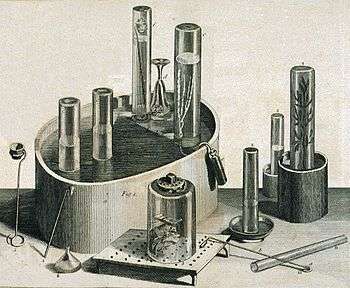Pneumatic trough

Pneumatic trough, as invented by Stephen Hales
A pneumatic trough is a piece of laboratory apparatus used for collecting gases, such as hydrogen, oxygen, and nitrogen. Pneumatic troughs require a liquid such as water. Scientists also have used mercury in pneumatic troughs, but usually only for the collection of water-soluble gases. Health-and-safety issues surrounding mercury generally prohibit its use in modern-day pneumatic troughs.
Four items are required for gas collection with a pneumatic trough:
- The trough itself, which is a large glass dish or a similar container
- A gas bottle (or bulb), to hold the gas collected
- A way to support the gas bottle or bulb, such as a Beehive shelf or a hanger (see picture)
- A liquid in the trough
The bottle is filled with water, inverted, and placed into the pneumatic trough already containing water. The outlet tube from the gas-generating apparatus is inserted into the opening of the bottle so that gas can bubble up through it, displacing the water within.
See also

Pneumatic trough, and other equipment, used by Joseph Priestley
Further reading
- Parascandola, John; Ihde, Aaron (1969). "History of the Pneumatic Trough". Isis. 60: 351–361. doi:10.1086/350503.
This article is issued from Wikipedia - version of the 6/29/2016. The text is available under the Creative Commons Attribution/Share Alike but additional terms may apply for the media files.